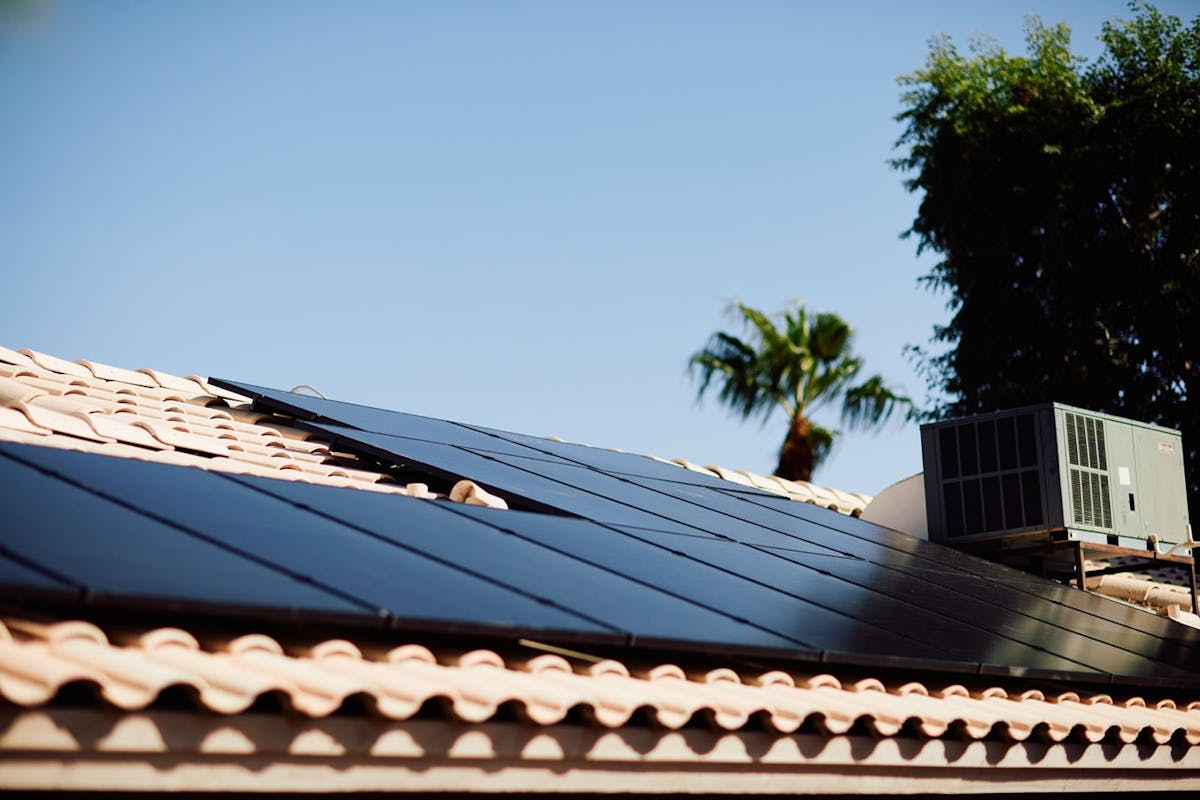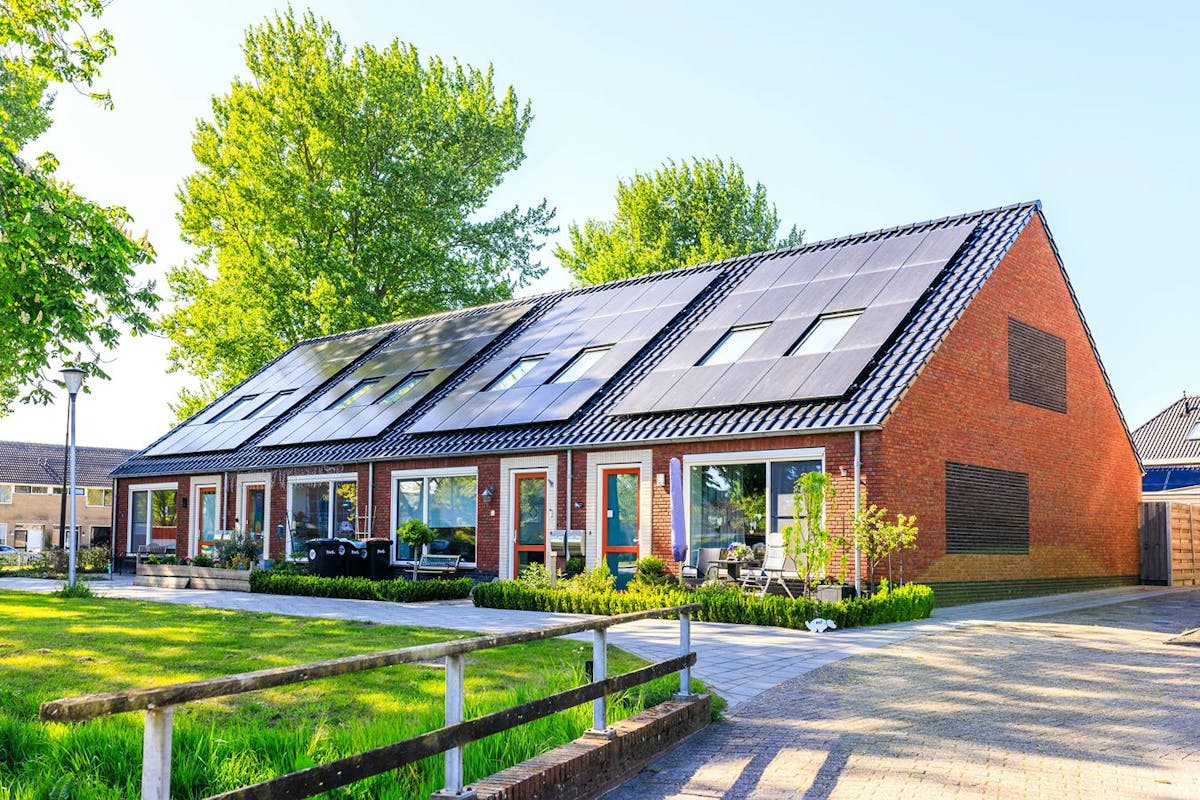How to Transition to a Clean Energy Home
Last edited

Author
Andrew Giermak
Solar and Electrification Writer and Editor

Editor
Andrew Blok
Electrification and Solar Writer and Editor

Using renewable energy instead of energy from fossil fuels can reduce your utility bills and your home’s carbon footprint. There are a surprising number of renewable energy options, including wind, hydro, and geothermal power.
When it comes to clean energy for your home, home solar panels and home electrification are the most practical paths to cleaner and less expensive energy because of their sustainability, functionality, cost, and ease of access.
See how much you can save by going solar with Palmetto
Understanding the Shift to Clean Energy
When someone says “clean energy" or "clean electricity," they generally mean any renewable energy source that does not produce greenhouse gas (GHG) emissions. For this reason, coal-fired power plants, natural gas, and other fossil fuels are not considered clean electricity sources.
Solar, wind, geothermal, and hydroelectric are among the world's most popular and fastest-growing clean energy sources. All across the planet, the shift to clean energy is part of a push to reduce carbon emissions and avoid the worst effects of climate change, improve air quality, and fortify electricity supplies.
In fact, renewable energy (all renewable sources combined) surpassed coal-powered energy and nuclear-powered energy in the US for the first time in 2022.
Source: eia.gov
How to Create Your Clean Energy Home
Renewable energy systems on your property can help offset greenhouse gas emissions from grid-supplied power, benefiting your community and reducing your electricity bills.
There are two key steps to move to a clean energy future at home: evaluation and action.
Step 1: Evaluate your home's energy profile
Whether you are building a new residence or making improvements to an existing property, you can evaluate your home's energy profile to find opportunities for adopting clean electricity and energy efficiency.
Replacing any fossil fuel-powered appliances in your home, such as a gas range or furnace, is an excellent way to set yourself up for a greener future. Additionally, your utility bills can give you an idea of your seasonal energy use. Devices like smart plugs can give you insight into specific devices’ energy consumption.
Consider partnering with a professional to conduct a full-home energy audit. With the help of an expert, you can further identify efficiency improvements, track down energy leakages, and determine what upgrades should be prioritized.
Whether you audit your energy use yourself or with professional help, getting to know your home's energy usage is essential to making smart clean energy efforts.

Credit: Department of Energy
Step 2: Make small steps and huge leaps
Once you've developed your road map, it's time to take action. Small but thoughtful home improvements like solar-powered garden lights, LED light bulbs, or a smart thermostat can help you reduce energy consumption and save money on utility bills.
Then, you can look at larger items, like swapping your furnace for a heat pump, installing energy-efficient windows, or exploring rooftop solar panels.
Why Solar Is the Leading Home Renewable Energy Source
For a clean energy home, photovoltaic (PV) solar power is the easiest and most effective way to lower your carbon footprint and utility bills for multiple decades in one fell swoop.
There are many reasons why solar energy has risen to popularity in the US and around the world, including its sustainability, versatility, and accessibility to homeowners.
Sustainability
Solar panels emit no greenhouse gases while generating new electricity. That’s great for the planet and local air quality. It can even improve your home’s indoor air quality.
Although there are some emissions associated with the manufacturing and transportation of the equipment (processes that are getting greener by the day), solar systems have significantly lower lifetime carbon footprints than fossil fuel resources.
Versatility
Solar panels are safely and effectively installed on rooftops (and in fields, floating on lakes, and in space). So, while logistics and building codes often make it difficult to install other renewable energy sources on a residential property, solar panels are on millions of American homes today.

Credit: Solar Energy Industries Association
Access
The cost of adopting solar has plummeted in the last 15 years, thanks to technological advancements, supply chain improvements, and support from local and federal governments. Although costs have stabilized over the last few years, the maturing residential solar panel marketplace is now filled with programs and incentives that make renewable energy adoption affordable.
See how much you can save by going solar with Palmetto
The Solar Installation Journey
When renewable energy at home is just a few solar panels away, making the right decisions for your installation is critical for long-term success. Partner with a reputable solar installer with a track record of smooth, quality solar panel installation and conscientious customer care before, during, and after your installation.
Here is a look at the solar installation journey broken down into three steps.
Step 1: Tailored solar panel solutions for homeowners
First and foremost, a solar installer should design a solar panel system to your specific roof and energy needs. An advisor may develop multiple solar options for your home while working to find the best one
Step 2: Financing your clean energy transition
The upfront price of solar panels can stop homeowners from going solar. It doesn’t need to, as there are many ways to reduce the cost.
You can take one of two main routes: purchasing your system or exploring solar lease or power purchase agreement options.
If you purchase solar panels, you are more likely to be eligible for federal, state, and local tax credits, rebates, and other incentives.
Leasing solar can reduce your energy bills while your installer owns, maintains, and monitors the panels on your roof. Palmetto's LightReach Energy Plan gives you rooftop solar panels for no upfront money and can deliver savings in its first year.

Credit: Solar Energy Industries Association
Step 3: Optimizing savings and renewable energy system management
If you decide to go solar with Palmetto, you can track every aspect of your renewable energy project's development in the Palmetto App. But remember, your clean energy home journey will not end on installation day because solar systems last for 25 years and more.
The Palmetto App allows you to track your solar production and electricity consumption. This allows you to identify when you are spending and saving the most and adjust your energy consumption to maximize your solar benefits. Regularly tracking your system's performance can also help you spot dips in production due to equipment damage or malfunction.
With the Palmetto App, you can schedule routine or emergency maintenance anytime to ensure your system always operates at peak performance. Palmetto Protect customers get proactive monitoring and comprehensive service.
The Home Electrification Process
Home electrification can be a step-by-step process or it can be a major whole-home renovation of appliances, systems, and vehicles. However you want to go about it, the idea is the same. You’re replacing any gas-powered appliances or systems with electric, no-emission, highly-efficient alternatives.
Pros and cons of home electrification
Along with your needs, and budget, the benefits and drawbacks to electrifying your home are important to consider.
Pros
- Reduces or eliminates gas bill
- Can be safer than gas appliances, especially for children and pets
- Can improve indoor air quality and reduce associated health risks such as carbon monoxide
- A smaller carbon footprint and less fossil fuel consumption
- Many local and federal incentives, like the Energy Efficient Home Improvement Credit, are available
- Easily integrated with solar panels
- Battery backup storage provides backup power and increases your likely savings with home solar power
Cons
- Can be expensive upfront depending on the appliance or system, or scope of the project
- Increases home electricity consumption, which can result in higher electric bills
- Your local electric rates compared to gas rates may make electrification less worth it, especially if you are not installing home solar panels
- Some incentives could be undone by legislation
- Payback periods vary between appliances
What Appliances and Systems Can Be Electrified?
Here are some of the most common projects that can achieve or support home electrification.
- Heat pumps: According to the US Energy Information Administration, heating and cooling takes up about 52% of an average U.S. home’s energy consumption. Heat pumps are the best current systems for energy efficiency. A heat pump can replace a gas furnace and an air conditioner.
- Smart thermostat: In conjunction with an efficient heating and cooling system, a smart thermostat can intelligently and automatically control your heating and cooling for optimal performance and efficiency. Smart thermostats offer more features which may help you save more and are smarter or more autonomous than older thermostats, even programmable thermostats.
- Stove/range: You can replace a gas stove or range with an electric or induction stove or cooktop. Both options are highly energy efficient. A gas range works at 32% energy efficiency. A newer model electric cooktop works at 75-80% efficiency. An induction stove has 85% energy efficiency. More reasons to switch include safety from flammable or harmful gas emissions inside your home.
- Electric vehicles: By charging an EV at home, you can shift your energy usage and spending from gas to electricity.
- Water heater: You can switch to an electric water heater, like a heat pump water heater, a tankless water heater, or a solar water heater.
- Dryer: If you have a gas-powered dryer, a new energy-efficient electric dryer is a possible upgrade.
Bottom Line: The Clean Energy Home Advantage
Every clean energy home improvement will help you lower your grid power or fossil fuel consumption, though nothing can do the trick quite like solar. If you are ready to learn more about the potential financial and environmental benefits of renewable energy for your home, check out Palmetto’s solar saving calculator or home energy advisor page.
See what solar can do for you:
Frequently Asked Questions
What are clean energy options for home?
Clean, renewable energy sources include solar power, water, wind, and geothermal energy. Solar and these other clean energy sources do not emit carbon emissions. Solar panels are one of the most practical and feasible choices for a home.
Who qualifies for the residential clean energy credit?
Taxpayers who make approved clean-energy or energy-efficient improvements to their main new or existing home can claim the credit. Qualified improvements include solar panels, solar water heaters, geothermal heat pumps, and battery storage, and must be new (not used) systems.



